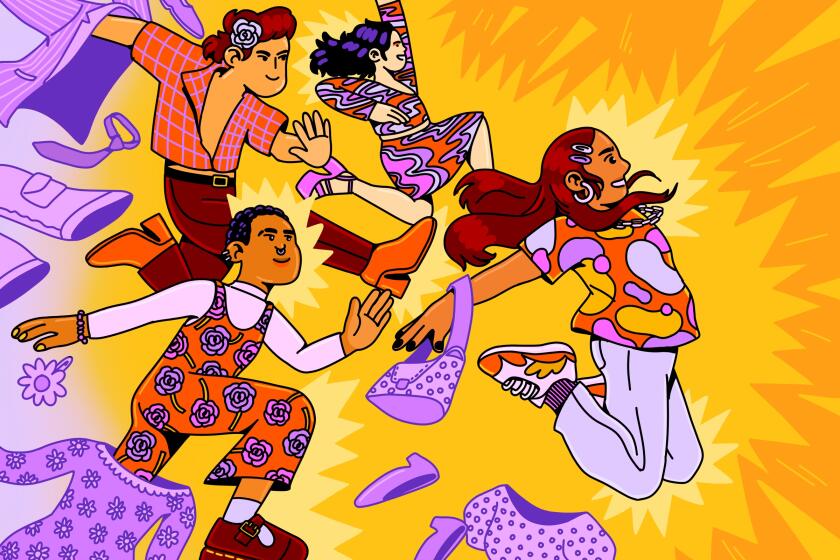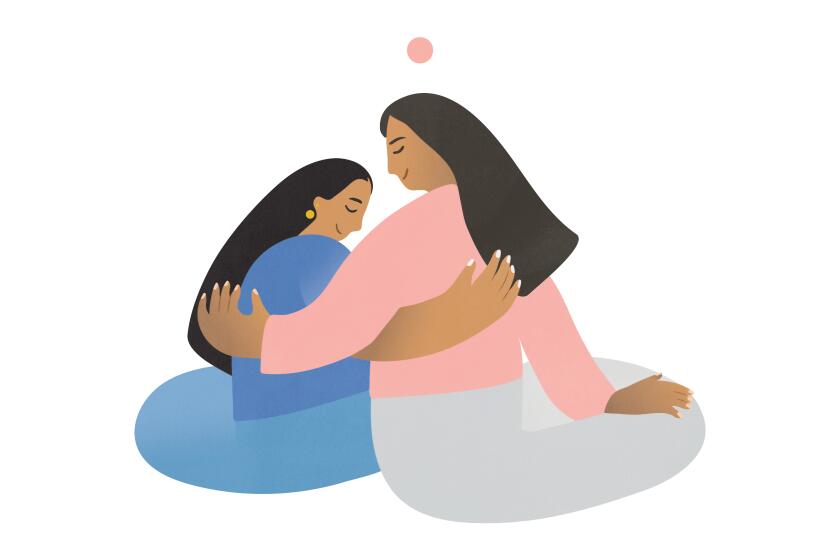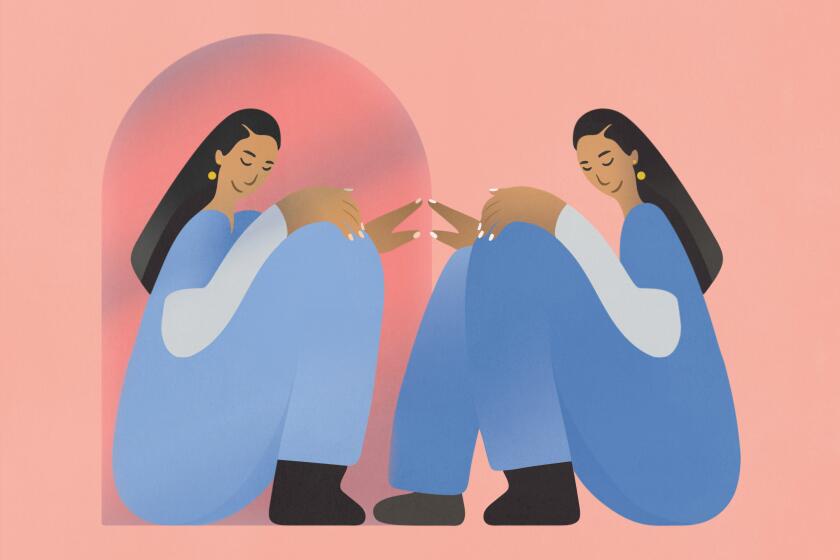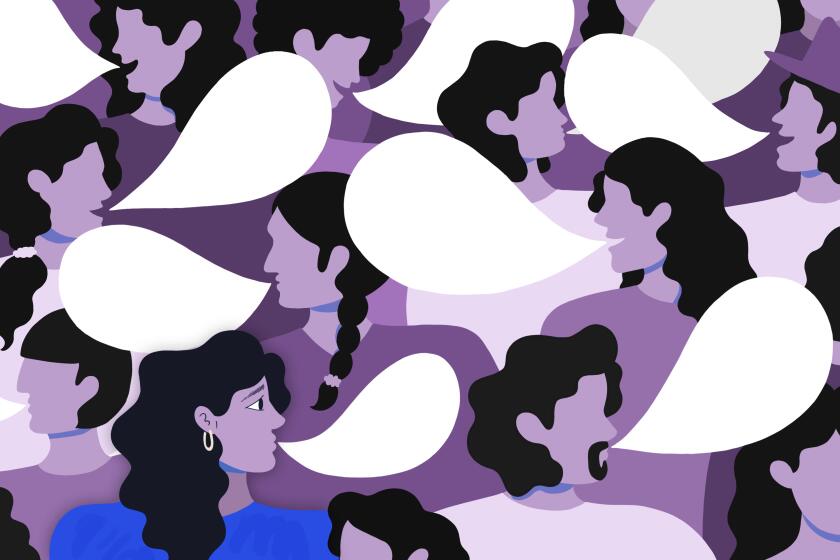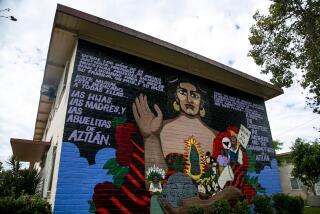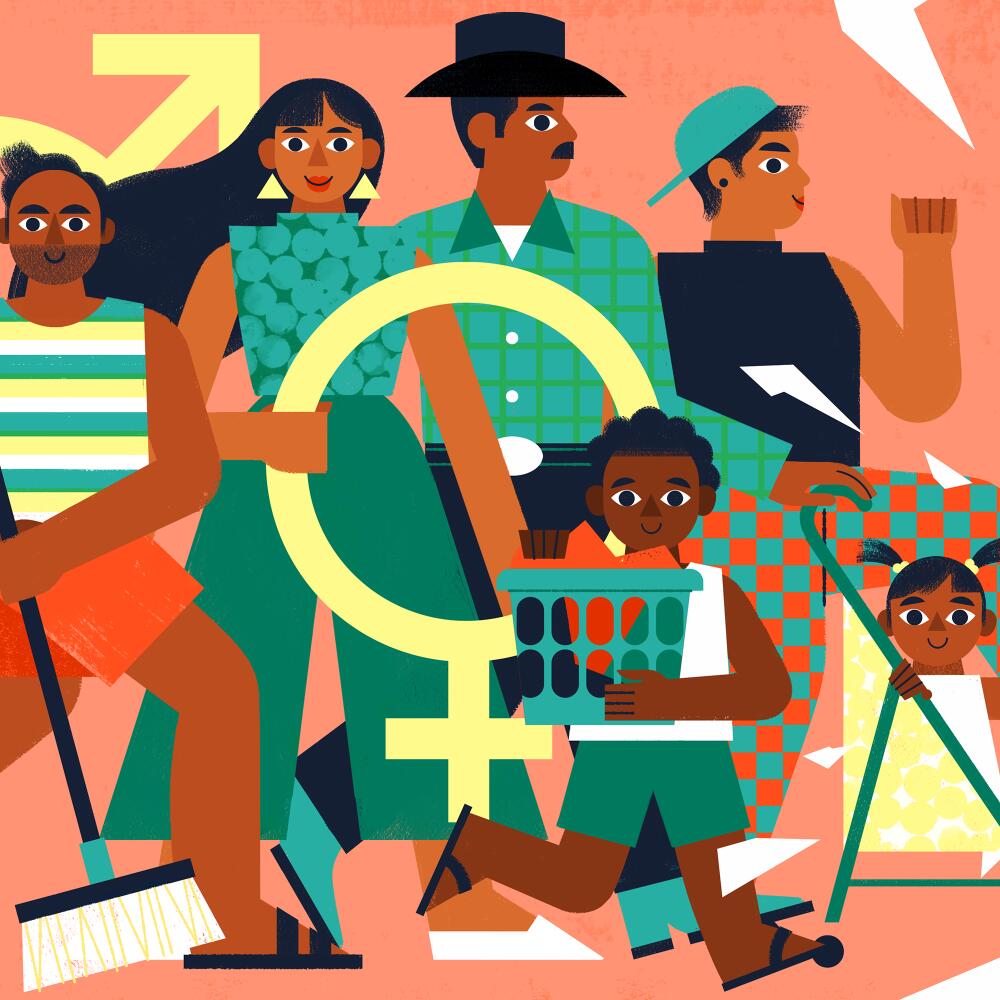
- Share via
Content creator Leslie Olvera recently explored why she felt guilty breaking away from the traditional values of her family and expectations of how to be una hija buena.
She devoted an episode of her podcast, “Your Latina Hermana,” to the topic of traditional female gender roles — and one specifically tied to Latino culture: marianismo.
Through the mic of her home office in New Jersey, Olvera said that by her family’s standards, una hija buena is being the caretaker for her siblings and helping run the household by cooking and cleaning.
Young, queer Latinos are breaking traditional gender expectations and claiming their identities on their own terms.
If she satisfied those duties, she was taught, it meant she was ready to fulfill the ultimate role that comes with being a woman.
“I would be told, ‘Ya estás lista para casarte,’” she said.
On the West Coast, clothing and lifestyle designer Brian Saucedo reminded his dad, Lino, about a recent phone conversation. Brian Saucedo was curating a fashion photo shoot for his company Ghetto Rodeo, an homage to growing up in L.A., earlier this year. And he told his father that he wanted to dress him in a skirt for the project.
Lino’s response was typical, “No. What are my friends going to say?”
During a recent interview in the Ghetto Rodeo showroom in El Sereno, the two reflected on the video, which made the rounds on TikTok and Instagram, documenting the photo shoot.
Lino and his friends, who normally talk and play dominoes in the park, were dressed in wide-leg pants and boots, paired with Ghetto Rodeo graphic T-shirts that read, “Ghetto Boys Cry Too.”

Brian Saucedo told his dad that the goal of the project was to get the men out of their fashion comfort zones — clothes they feel define them as manly.
“No naciste macho,” he tells his dad, and it launches them into a conversation about machismo, a male gender role that broadly assumes Latinos are dominant, aggressive, honorable, reserved and chauvinist.
Saucedo and Olvera are cisgender creatives who are contributing to a larger conversation that young Mexican Americans and other Latin Americans across the U.S. and beyond are having about letting go of or subverting monolithic gender role norms.
Questioning gender role origins
What are machismo and marianismo?
Mental health professionals told The Times that machismo and marianismo are cultural constructs deeply rooted in Latin American and Mexican American societies, influenced by Spanish colonization, Roman Catholic teachings on family life and indigenous beliefs. Machismo, associated with traditional masculinity, emphasizes dominance and control, while marianismo idealizes women as virtuous and self-sacrificing.
“Marianismo” references the Virgin Mary and describes societal expectations of purity, virtue and caretaking. The term was coined by Evelyn Stevens in 1973. The UC Berkeley political scientist argued that marianismo and machismo could not exist without one another.
Norma Contreras, a Fullerton-based associate marriage and family therapist, discusses with her clients how diverse gender expectations in Latino culture can be influenced by cultural factors, including religion.
“Younger Latinos are starting to get more therapy because they realize that [traditional gender norms are] not natural and they want to end that cultural normalization of it,” Contreras said.
She underscored the diversity among Latino families — the norms are generalizations and don’t describe all Latinos.
Machismo and its implications have been written and talked about extensively in research papers, articles and books. Marianismo, though, has finally moved from a mainly academic discussion to social media, podcasts and other mainstream creative platforms.
As the term is being talked about along with personal experiences across TikTok and Instagram, Angelica Tello said, “there may be some aspects of internalizing that can take place.”
Tello, an associate professor of counseling at the University of Houston-Clear Lake, criticizes the term, saying it’s “an outsider’s perspective of Latina experiences.”
The term was coined 1973 by Evelyn Stevens, a white academic and political scientist, who was describing gender roles in Latin America. Stevens’ research has led marianismo to be described by scholars as if it were rooted in Latin American culture, Tello said.
But in the mental health field, especially psychology, Tello argues, “this ends up pathologizing Latinx culture and doesn’t shed light on how society as a whole, not just in Latin American countries, fosters patriarchy.”
To avoid that, she said, when mental health professionals, content creators or anyone else talk about mental health, they should also be discussing societal factors that affect our lives and mental health.
She gave the example of parents in a mixed status (documentation status or multigenerational) Latinx household who are overprotective of their family members due to experiences of racism, classism or genderism in the United States.
“I’m not saying that a parent’s controlling behavior is OK, but it can help put into context what is occurring before quickly pathologizing a Latina as being co-dependent because of the relationship she has with her parents,” she said.
Tello added: “The mental health field perpetuates the idea that Latinas may struggle with their mental health due to marianismo, and this has undertones of saying that Latinx culture embodies marianismo and therefore Latinas have mental health issues due to their culture.”
Stories and advice about Latino mental health
So why are we seeing this discussion online now? Information is more accessible, and more Latinos are entering the mental health field, said Lisette Sanchez, a Long Beach-based licensed psychologist.
Words and definitions change all the time, Sanchez said, “and we have the opportunity to reclaim terms all the time.”
“If [marianismo] gives someone purpose, and they find joy in whatever the traditional definition of marianismo is, and it’s not a sense of obligation to them, then who am I to judge?” she said.
Cynthia Perez, a Long Beach-based licensed clinical therapist, noted that positive qualities come with marianismo — women building community or safe spaces and being resourceful.
Is it the gender roles or the socially constructed roles that were placed upon Latinos, erasing the individuality of the Latin American experience, that hinders someone?
It’s a question you’ll ask yourself when you’re questioning whether or not this categorization serves a purpose in your life.
The effects of gender roles
It wasn’t until Perez became a mother that she realized how marianismo had disrupted the connection she wanted with her children.
She remembers struggling with feelings of restlessness, disassociation, inadequacy and stress.
Perez found that she, like her mother, didn’t know how to stop busying herself to rest or be present with her children.
She also didn’t want to criticize her children the way she was criticized.
For example, Perez’s mother once told her: “Don’t get a master’s degree. Men won’t want to date you because you’ll have more than them.”
That may have been a cultural and gender norm for her mother, Perez said. But not one she wanted to carry on.
“When we make women feel they need to be perfect and graceful and beautiful and domestic all the time, at all hours, we are setting unattainable standards,” she said.
The harm extends beyond the home and into the workforce.
In observing conversations on marianismo, Tello said, Latinas often talk about struggling to balance family and community expectations with what they want to pursue in their professional lives.
Latinas are part of a collectivist culture (helping family and community), but the individualistic lifestyle that is the United States’ professional workforce is a source of friction.
It’s further intensified by having to navigate a career that a Latina’s family might not understand — making her feel isolated and overwhelmed, she said.
First generation trauma is an emerging term in the Latino community, with people talking about it on social media. Here’s how it affects children of immigrant parents.
How people are breaking gender role cycles
Healing from traditional gender norm expectations for Olvera includes sharing her experiences through content creation and the “Your Latina Hermana” podcast.
Through those creative channels, Olvera also shared one specific healing practice: becoming more conscious of her thought process.
“I used to believe that my worth was solely based on performance or what I could offer to my family and others,” she said.
“However, I now remind myself that my value is not solely based on my performance nor what I can provide.”
You can seek assistance from an individual or group therapy session or practice letting go of norms that don’t serve you on your own.
The work that comes with leaving behind the gender norms is asking yourself, “Who are we learning these roles from?” Sanchez said. “What are we accepting and rejecting from these traditional practices?”
One exercise Sanchez recommends is understanding your values. It’s helpful to get an understanding of what you value; realize it might differ from the values you were raised on.
Sanchez suggested a card sorting exercise. She pointed to a printable version from the Good Project, a research initiative by the Harvard Graduate School of Education, that has 30 cards with various titles, including recognition from one’s field, independence, curiosity. You can also make your own. Once you have the cards, sort them by relevance to you under the categories of least important to more important.
Once you complete the exercise, Sanchez said, take time to journal and reflect.
Ask yourself:
- Did you enjoy it?
- How long did it take you?
- Was it difficult to make a decision? If so, what made it hard?
“When we are clear on our values, that can also help us understand why we may be experiencing conflict or feeling indecisive,” Sanchez said.
This exercise can help you understand which values might be in conflict with a gender norm and provide clarity about where your discomfort is coming from.
“Once you have that information, you can begin to shift your behavior to be more aligned with your values and feel more confident that you are making the best choice for you,” she said.
Language and culture are intertwined, and many Latino Americans are seeking to learn or improve their Spanish to form deeper connections with family and their own identities.
Perez hosts in-person and virtual workshops where she talks about “inner knowing,” a feeling of “obligation or guilt we feel to show up a certain way and how it really limits us from expanding.”
Most participants are quiet at first, she said, because they aren’t aware of that term or the extent of influence these gender roles have on their identities.
Another exercise Perez recommends is visualization. When you feel you are people-pleasing or the moment you realize you’re falling into a social norm, Perez suggests going out in nature. And if you don’t have access to nature, step outside of the environment you’re in. Then close your eyes. Visualize yourself in a safe space and give yourself compassion. Question why you’re feeling negatively and give yourself some kind words.
“What your brain thinks, it believes. And that is the power of visualization,” Perez said.
“So if you imagine a peaceful conversation and allow yourself to let go, your brain tells your body it’s safe to let it go. And you’ll feel a little bit lighter and hopefully more present.”
Another tried-and-true method is to talk things over with sympathetic friends — maybe after you’ve all read this article.
Back in the Ghetto Rodeo showroom, Lino Saucedo tells son Brian Saucedo that after the photo shoot, he now believes the younger generation isn’t as focused on what categories a man and woman should fall into — down to how each gender should dress.
On his left hand, Brian Saucedo has a tattoo that says. “Be you.” That’s what he tries to live by and what he hopes others realize they can do.
To spread that message, Brian Saucedo said, he’s having conversations or starting projects with his dad and with the community Ghetto Rodeo is fostering.
Olvera is proud to be the cycle-breaker in her family while navigating new territory in all aspects of her life and dealing with the potential lack of understanding from others.
“I’m changing the trajectory of how future generations can communicate, express themselves and build healthier relationships,” Olvera said.
More to Read
The Latinx experience chronicled
Get the Latinx Files newsletter for stories that capture the multitudes within our communities.
You may occasionally receive promotional content from the Los Angeles Times.

